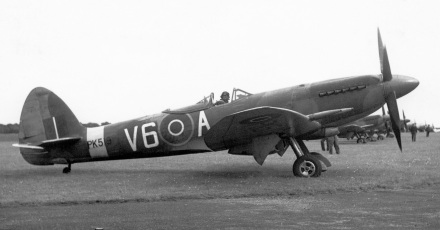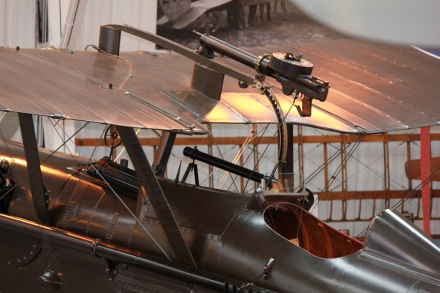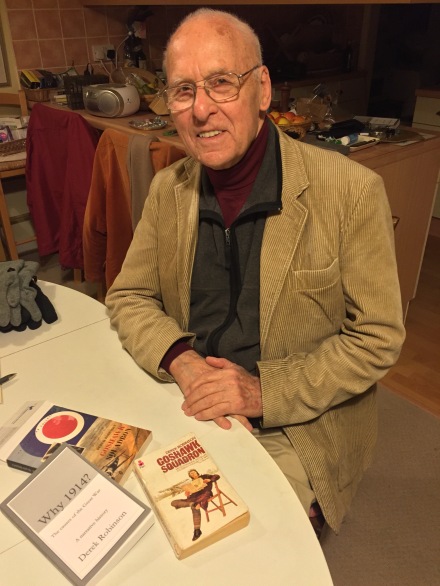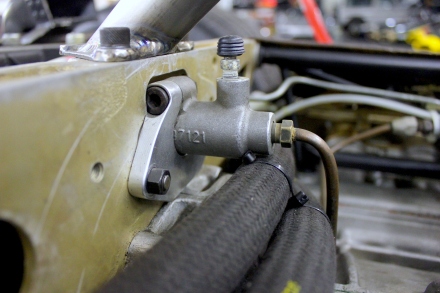They say that you should never meet your heroes for fear that they may leave you disappointed. The S&G’s recommendation is simply to pick your heroes wisely. In writing the Haynes Manual on the Royal Aircraft Factory S.E.5, the defining day of the whole experience came in Bristol with the opportunity to interview the man who first made this writer want to tell stories of any kind: Derek Robinson.
It’s nearly 50 years since Robinson turned the literary world on its head with Goshawk Squadron – the Booker Prize runner-up of 1971. Until its publication, the image of airmen in World War 1 had been based upon the myth of a ‘cavalry of the clouds’ (as Lloyd George’s spin doctors put it). They were daring, chivalrous knights of the air jousting high above the squalor of the trenches with their silk scarves a-flutter.
Robinson wrote of a war that was no less squalid than that on the ground from the perspective of an S.E.5 squadron commanded by Stanley Woolley; a foul-mouthed working class combat veteran. Woolley presides over a rabble of idealistic young public schoolboys who believe that they are taking part in a gallant contest with the enemy – a delusion that Woolley tries to beat out of them by any means necessary.
The inspiration for his story had come in 1968, when the Sunday Telegraph ran a feature marking the 50th anniversary of the Royal Air Force in which a First World War veteran was interviewed. ‘He said it was much more like meeting a guy down a back alley with a sock full of broken glass and cracking him over the head and running like hell,’ Robinson remembered.
‘He said it was just as bad to be shot at 15,000 feet as it was in the trenches so let’s forget all the chivalry stuff, there was no fair play, there was no duelling in the sky… I was reading this and thought: “Hey! Never thought of that!” So that was it, after that I was off and running and so I read everything that I could lay my hands on.’
There were two things that Derek Robinson knew about – writing good copy and the Royal Air Force. The former came from a career spent in the advertising trade, a fair bit of local journalism and generally being a pen for hire… whilst all the while dreaming of writing the perfect detective novel. When it came to writing about wartime airmen, however, the aspiring novelist was able to draw on a wealth of first-hand knowledge as a trained radar operator and fighter plotter.

Robinson’s characters owe much to his encounters with WW2 veterans while on National Service
‘I did my national service in the RAF and I knew various pilots – this was at the time of Korea, and the reserves had been recalled from among the pilots of the Second World War,’ said Robinson.
‘I was at Exeter Airport and one of these reserve squadrons arrived in Spitfires and flew there all summer… and of course they were all crackers.
‘The railway line comes out of Exeter and it runs through alongside the River Ex estuary and then it goes down the coast to Cornwall. Because it’s marshland down there the railway line is built up on embankments and these guys in Spits used to hang around – we could watch them from the radar station, we could see it – so when the train was steaming out of Exeter and picking up speed they used to dive down and sweep level with the train driver. A lot of that sort of behaviour went into Goshawk Squadron and all the books.’
The full canon of Robinson’s stories of the air begins with a quartet of tales from the First World War that run chronologically from the Battle of the Somme in 1916 (War Story, 1987), to the battles of Arras and Passchendaele in 1917 (Hornet’s Sting, 1998), to the German Spring Offensive in 1918 (Goshawk Squadron, 1971). The final instalment tells of the deployment of Royal Air Force units to fight for the White Russians against the Bolsheviks in 1919 (A Splendid Little War, 2013).
Then we get to World War 2, in which the series begins with Piece of Cake (1983), the story of an RAF fighter squadron from September 1939 to September 1940. Intertwined with this is a later book, Damned Good Show (2002), which tells the story of the bomber crews in 1939-41 before the arrival of ‘Bomber’ Harris as their commander.
The survivors from Piece of Cake are then found in the vast expanse of the Sahara, fighting Rommel’s Afrika Korps alongside the SAS during 1942 (A Good Clean Fight, 1993). The WW2 quartet ends with Flight Lieutenant Sweet, the central character from Damned Good Show seeing out his war, struggling in civilian life and jumping at the chance to fly a nuclear-armed V-Bomber at the height of the Cold War in Hullo Russia, Goodbye England (2008).
‘I don’t know of anyone who is competing with me: I don’t know anyone who writes this kind of stuff about First and Second World War flyers,’ Robinson said. He has a very good point as well but sells himself rather short because no novelist has ever come as close to explaining the truth of war in living memory.
Certainly in the case of airmen, only the terminally ill First World War pilot Victor Yeates, in his book Winged Victory (1934), really compares in terms of the rawness and the willingness to address uncomfortable truths. Unlike many veterans who have written about their wartime experiences, Yeates wrote without a care for how posterity might view him or his comrades. Even after a century it is a truly shocking read.
In recent times, novels that have been set in either of the World Wars have merely used elements of the conflict as a backdrop to melodrama. If you read Birdsong after reading Goshawk Squadron, then Sebastian Faulks’ efforts are revealed as a genteel middle-class soap opera that pays only lip service to military history.
‘I’m pretty good at what one critic described as “putting people in the cockpit”,’ said Robinson.

Goshawk Squadron puts the reader here, sat between two machine guns at 15,000 feet
‘So you feel you know what it’s like up there and it’s complicated, it’s difficult, it’s dangerous and yet it’s hugely exciting and you can do things up there that nobody could dream of. I research that very, very closely but I don’t put a lot of process and procedure in the books because people get fed up with it pretty quickly – but it informs the story. Secondly, the jokes are not bad!’
In fact, the rich vein of humour that runs through all of the books is often riotous. In Robinson’s version of events, the pity of war is something that we the readers experience through the author’s voice or characters like the outspoken intelligence officer ‘Skull’ Skelton who appears in every one of his World War 2 books – usually before getting the ‘chop’ and being sent to some backwater or other as penance.
The airmen seldom, if ever, take time for a wistful glance or mournful sigh – they’re too busy living and dying. Gravitas, pity and sorrow are what we bestow upon wars long after the event, like a hushed BBC commentary on Remembrance Sunday.
‘It’s a point I try to make that, for these young men, being given the most amazing machinery of their times and the means to shoot things down and blow things up – it was bloody good fun!’ Robinson chuckled. Over the years some veterans have complained that he has not done their legacy any favours – but on balance many more have found the ebullience of his fighting men to be right on the money.

Derek Robinson at home with a selection of his handiwork. A thrilling interviewee for a writer.
‘I was talking to a D-Day veteran once, and he was complaining that we make such a fuss about that landing when there were others before it that never get a mention,’ Robinson recalled.
‘He said: “I remember when we were going into Sicily, and we were in the landing craft, and the Lieutenant stood up in front of us and he said that it was going to be rough stuff that we were going into and it may well be that half of the men in that boat would not be coming back.” And this chap said that he looked around at the bloke next to him and he thought: you poor bastard!’
In recent years, Robinson has produced two non-fiction books that tackle big issues in popular military history. First came Invasion, 1940 which looks at whether or not Britain was in fact under imminent threat of German occupation during the Battle of Britain. In Why 1914?, Robinson’s gimlet eye for history was turned upon the circumstances and misadventures that fuelled Europe’s descent into the First World War.
These books, together with his authoritative works on Rugby Union, books about his beloved Bristol, a series of spy stories and even an American novel, all delight the Robinson faithful. But it is the stories of airmen that have come to define his oeuvre – all of which stem from the writing of Goshawk Squadron.
‘We were on our uppers but I guess it’s part of being young and having lots of energy – I had a lot of energy in those days. And a fair bit of anger at the world in general,’ Robinson said.
‘I wrote it – according to my wife, who remembers it far more vividly than I do, I’m sure –not so much in a fit of rage but in a fit of defiance. I had already wasted four years writing stuff which nobody wanted to publish. So I said to myself – and I think I said to her too – “well, I don’t give a shit. I’ll write it for me and if somebody else wants to publish it then that’s good luck!” …that’s what I should have done in the first place!’
Although now in his eighties, Robinson remains a cheerfully restless author. The shelves of high street bookshops are groaning under the weight of newer and lesser war novels, while the maestro’s most recent works are mostly self-published and sold directly to his followers. Such is the case with his latest novel, Holy $moke, which came out last year and follows a mismatched group of intelligence men into Rome and the chaos that reigned after Mussolini’s fall.
One cannot help but feel that a return to the screen is long overdue. It’s 30 years this year since Piece of Cake was broadcast as a six-hour miniseries by ITV but it remains utterly fresh and vital, thanks in no small part to the source material. Sir Peter Jackson has built an entire air force of 1914-18 machinery – not to mention a hangar full of Lancasters – and has yet to find a suitable vehicle for any of them. He need hardly look further than Bristol for inspiration.
All of Robinson’s books can be ordered directly from the man himself by visiting www.derekrobinson.info and this is to be heartily recommended. As for the S&G, our time of chuntering about old aeroplanes and good books, with accompanying tea and doughnuts, will long be remembered. Because sometimes meeting your heroes is very well worth it.











